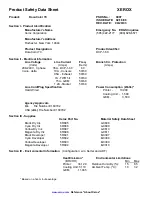
The GS8920 can
automatically
deal with all of these problems as it includes extensive serial input self
checking and automatic error correction algorithms which enable it to continue proper operation in the
event of corrupted serial data. Switching should, however, be confined to periods when the GS8920 is
in its normal operating mode and NOT in the process of printing a ticket.
The GS8920 automatically detects the weight indicator’s decimal position and can therefore be used to
print tickets from indicators with differing display setups - however - as numbers within the GS8920
are treated as though they do not contain a decimal place there can be some confusion concerning the
value of accumulated weights. Only in special and carefully considered applications should multiple
indicators be used which have different decimal place positions.
Many Gedge Systems weight indicators include a device number in their serial transmission. Since this
device number is user settable and is printed on every ticket, the source of the weight can be identified
in multiple indicator applications by the use of the device number.
2 .5 .1 .2 Connection to GS Weight Indicators.
The Gedge Systems digital weight indicator must be fitted with an Option 02 or an Option 05. The
method of setting the transmission rate and the parity is fully contained in the weight indicator’s
installation manual in the sections “Options” and “Digital Setup” - this manual MUST be used to make
these settings. Where no parity setting is available on the digital weight indicator then the GS8920 will
set itself to ignore the parity bit or if the parity is even to set itself to even parity.
The weight indicator’s serial data transmission rate setting is made via switches on the Option 02 or 05
board within the weight indicator and may be any of the following baud rates :- 600, 1200, 2400, 4800,
9600 or 19200. ( 4800 baud is recommended. )
The parity setting, if available, is made via the digital indicator’s “Digital setup” and may be EVEN,
ODD, always 1 or always 0. The GS8920 will use EVEN parity if it is detected otherwise the GS8920
sets itself to ignore the parity bit and to send data with the parity bit set to Zero. ( ie b7 = 0 )
2 .5 .1 .3 Connection to Toledo Weight Indicators.
The GS8920 Ticket Printer may be connected to any digital weight indicator manufactured by Toledo
provided that it has a serial output that complies with the following specification.
RS-232C or 20mA Active Current Loop 4800 baud Hi Speed ASCII Data Output Format with 1 start
bit, 7 data bits, 1 even parity bit and 2 stop bits. If the optional checksum character is transmitted it is
ignored by the GS8920. The indicator must be set up with “below zero blanking” disabled.
The Toledo indicators referred to transmit the Gross, Tare and Net weights. Therefore, the GS8920
Ticket Printer may be set up to use the Gross, Tare and Net weight from the Toledo indicator or may
be set up to allow the operator to key enter a tare weight via the GS8920’s keyboard.
Additionally, the data stream transmitted by these indicators DOES contain a “Print” function,
therefore the GS8920 may be instructed to print a ticket form the digital weight indicator’s front panel
as well as from the GS8920’s keyboard.
The installation engineer must refer to the weight indicator’s manual to obtain the procedure for
establishing the above settings.
Interconnecting cables are NOT supplied for connection to indicators not manufactured by Gedge
Systems. The installation engineer will need to make up a cable which conforms to the figure below.
GS8920 Intelligent Ticket Printer.
2-10














































